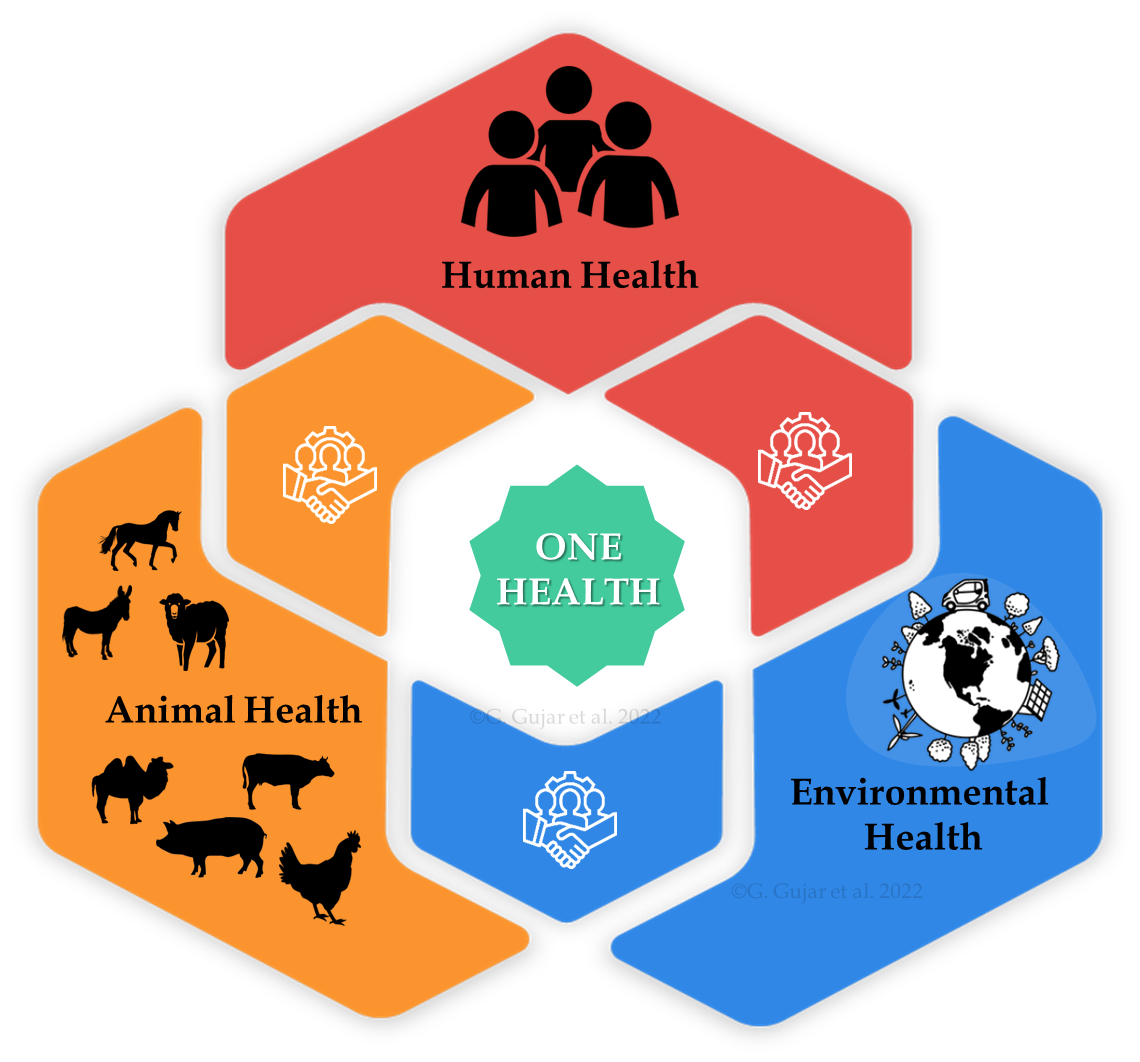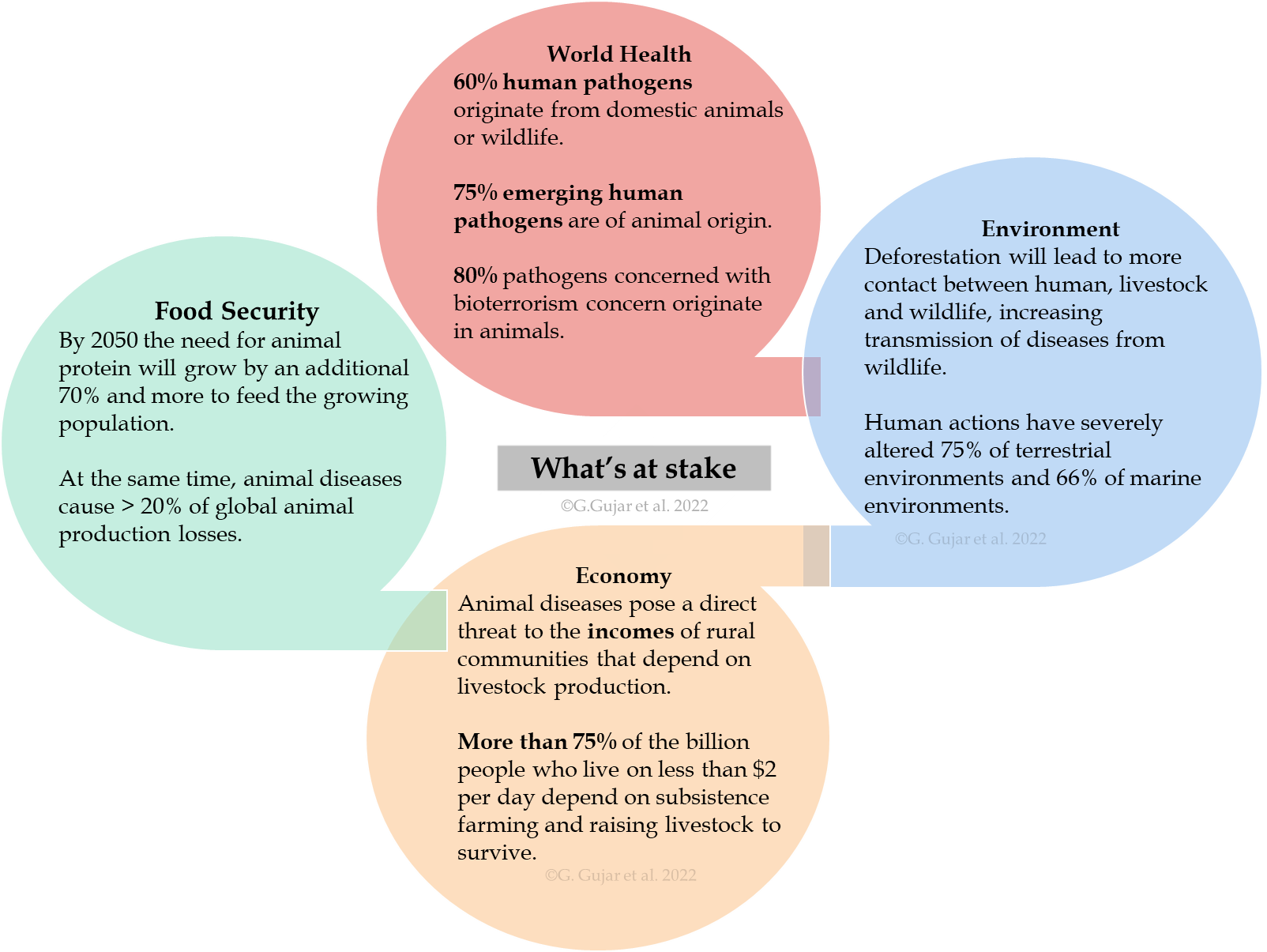One Health and Global Animal Production
One Health and Global Animal Production
Concept of One Health and Global Animal Production
The recent corona pandemic has brought human health and related vulnerabilities into the centre of all debates concerning the future of human health, and factors that influences it. The fact that the novel corona virus is believed to be the result of host jumping has put the importance of zoonotic diseases, their control and awareness into focus. It is a well-known fact that the health of all species on this earth and the health of earth itself are intertwined in a pretty complex manner. This is the relationship upon which the concept of “One Health” builds upon.
Understanding One Health
 As defined by the One Health High-Level Expert Panel (OHHLEP), “One Health is an integrated, unifying approach that aims to sustainably balance and optimize the health of people, animals and ecosystems. It recognizes the health of humans, domestic and wild animals, plants, and the wider environment (including ecosystems) are closely linked and inter-dependent” (OHHLEP, 2021).
As defined by the One Health High-Level Expert Panel (OHHLEP), “One Health is an integrated, unifying approach that aims to sustainably balance and optimize the health of people, animals and ecosystems. It recognizes the health of humans, domestic and wild animals, plants, and the wider environment (including ecosystems) are closely linked and inter-dependent” (OHHLEP, 2021).
One health recognizes what has been an understanding about the interconnectedness and interdependence among people, animal and environment when it comes to their health, puts its importance into perspective and identifies the issues related to vulnerabilities, impacts and associated factors. This approach brings together expertise from human health professionals, veterinarians, environmentalists and socio-economic fields with the aim to achieve healthy people, animal and environment, promoting trans-disciplinary decision making to make use of knowledge from varied domains to find solutions which are varied yet common in their consequences.
This could be achieved by a change in outlook and action, which requires a shift from traditional disease-focused approach to a largely systems-based approach. This implies refocusing the resources from treatment and control of diseases towards disease surveillance, preparedness and prevention, which needs evolution of new perspectives, institutional arrangements and finding innovative technological solutions. It also requires newer approaches to share evidences, data, and learnings transcending disciplines and sectors, so as to avoid duplication of effort, and maximize the resource utilization to achieve a common goal in a synergistic manner.
Why One Health?
The emergence of new diseases and potentiation of older infections with the changing scape of interactions between human, animals and environment that is compounded by biodiversity loss, ecosystem alterations and climate change, with infections having potential of becoming pandemics exposes our vulnerabilities to the newer challenges.
 On the other hand, over reliance on antimicrobials to deal with these infections and as prophylactic measures have increased anti-microbial resistance (AMR) producing ‘superbugs’ which are able to withstand a wide array of drugs and making treatment of some ailments largely untreatable, and we are left with no answers to these superbugs.
On the other hand, over reliance on antimicrobials to deal with these infections and as prophylactic measures have increased anti-microbial resistance (AMR) producing ‘superbugs’ which are able to withstand a wide array of drugs and making treatment of some ailments largely untreatable, and we are left with no answers to these superbugs.
The recent COVID-19 pandemic is a testament to the susceptibility of all systems to a large-scale pandemic that had ramifications for human life on an unprecedented level, breaking down economies, pushing millions into poverty, taking million lives both in the developed and developing world. The world is still reeling from the after effects of devastation unleashed by COVID pandemic. This has also led to the realization that the world today can’t shy away from the fact that a global coordination is required if such pandemics are to be averted in the future, or the losses from such pandemics has to be mitigated so that the world is not brought to a standstill.
The health challenges emerging out of these issues disproportionately affect the population of developing and under developed countries, making millions of them vulnerable to poverty, food insecurity and climate change driven migration.
How One Health Approach Helps?
The “One Health” approach proactively engages disciplines of human medicine, veterinary medicine, and environmental health sciences, bringing together expertise to attain optimal health for people, animals and our environment.
- One Health can help achieve progress on national and global priorities. Strengthening public health systems at the human-animal-environment interface protects health, agricultural production, and ecosystem services—including food and nutrition security to disaster resilience and ecotourism--all of which contribute to economic development.
- Actions to address disease risk and prevent disease emergence at the source are a key part of the One Health approach. This includes improving animal health and welfare.
- The One Health approach promotes synergies at national and global levels. The One Health approach is endorsed by international agencies such as WHO, FAO, OIE and their Tripartite alliance.
- One Health strategies are highly cost-effective. One Health improves effectiveness of core public health systems, substantially reducing morbidity, mortality, and economic costs of outbreaks.
Priorities of One Health Approach
- Improving early warning systems on animal and plant pests and diseases, including zoonotic diseases at the human-animal-plant-environment (HAPE) interface.
- Strengthening biosecurity for pest and disease management in animals and plants, including zoonotic diseases, pests and invasive alien species management.
- Facilitating effective emergency preparedness and response for anticipatory action on and response to food-chain emergencies, food safety issues and other health events at the human, animal, plant and environment interface
- Heightening AMR risk management at national, regional and global level by supporting One Health responses to AMR in the food and agriculture sector
- Enhancing One Health systems through strengthening contributions to One Health and biodiversity, and its ecosystem services, environmental health, soil/land, water, food safety and the sustainability of agri-food systems.
Conclusion
By striking a balance between meeting the demand for animal products and focusing on mitigating health risks in ways that take account of both livestock livelihoods and reducing the environmental impact of the livestock sector, livestock production can be sustainable. A One Health approach can help make livestock systems sustainable and equitable while enhancing animal, human and environment health.
References
- FAO & OIE, 2015. Global control and eradication of peste des petits ruminants Investing in veterinary systems, food security and poverty alleviation
- World Bank, 2021. Safeguarding Animal, Human and Ecosystem Health: One Health at the World Bank. https://www.worldbank.org/en/topic/agriculture/brief/safeguarding-animal-human-and-ecosystem-health-one-health-at-the-world-bank retrieved on 14/08/2022.
Content Contributors
- Gayatri Gujar, PhD, Livestock Production management, CVAS, RAJUVAS, Bikaner, Rajasthan
- Monika, PhD, Veterinary Parasitology, CVAS, RAJUVAS, Bikaner, Rajasthan
- Soumya Dash, Scientist, ICAR-National Institute of Biotic Stress Management, Raipur, Chhattisgarh
Last Modified : 8/21/2023
The Office of the Principal Scientific Adviser to ...
Provides information about AYUSH-64 for treatment ...
Tips for handling mental issues during pandemics/d...
This topic contains the information related to Bio...
